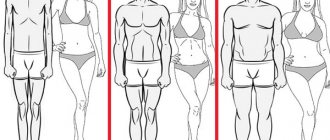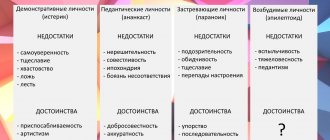Do you know that by understanding your type of perception (who you are: visual, auditory, kinesthetic, digital) you can increase the quality and speed of your learning and be able to convey your thoughts to a person with high accuracy? How to determine the types of information perception and how to use this knowledge in communication and learning will be discussed in detail in this article.
A ten-year-old child who was considered completely incapable of learning was brought to a wise teacher. Parents complained that no matter how hard they tried, they could not teach their son the simplest arithmetic. No matter how hard they tried to fold sticks, apples, or point with their fingers, nothing came out. He couldn't learn to add and subtract. The teacher talked to the boy for a few minutes. Then he asked his parents to sit aside while he taught their boy to count. Then the teacher asked the boy to stand up and jump over the pebbles. At first the boy simply jumped over the stones. Then the teacher said: “Look, do one jump, then a second, and then jump twice more. How many times did you jump in total?” And suddenly the boy answered - 4. Then the boy jumped and counted even more, in one day he mastered arithmetic, which ordinary children master in six months. The parents sat with their mouths open.
Why was this possible? The teacher was wise. He understood that this boy needed to be taught a lesson in such a way that he would be able to perceive it . He didn’t just hear, but perceived it in the way that was most understandable to him.
Today we will talk about what types of perception there are, and how understanding the types of perception of information helps in relationships and learning. And also about how to determine your type of perception.
In the simplest approximation, there are four types of information perception: visual, auditory, kinaesthetic, digital.
Channels of perception: visual, auditory, kinesthetic, digital
A person perceives information through the main five channels: visual, auditory, tactile, gustatory, olfactory. And after perception, the information is processed in our head, and the interesting thing is that it is processed on the basis of one prevailing system .
There are four main types of sensory systems:
- Visual. When the visual information processing system is dominant: shape, location, color.
- Auditory. The auditory information processing system is dominant: sounds, melodies, their tone, volume, timbre, purity
- Kinesthetic. Sensory information is dominant: touch, taste, smell, sensation of textures, temperature
- Digital. Associated with the logical construction of internal dialogue.
One should not think that the dominance of one means the weakness of the other. It’s just that one of the systems is most often the starting, leading one. It is the leading system that launches the thinking process and becomes the impetus for other mental processes: memory, representation, imagination.
For example, you are told, “Imagine the soft fur of a cat.” In order to visualize fur, you must first imagine a cat, and only then remember how soft its fur is. The auditory person first imagines the sounds of a cat (purring, meowing), and then can remember other sensations. The kinaesthetic sense immediately senses the touch of fur, and only then the visual image. Digital needs to say cat to himself and, after internal speech, imagine the image of a cat and fur.
Each of us sees the image of a cat in our heads, but for some it pops up immediately, and for others through their dominant system. The trigger system helps quickly translate a stimulus into images in our brain. That is why understanding your leading system allows you to individually and accurately create the principle of perception and memorization of any information.
Visual sensory representational system
People with a dominant visual sensory representational system think in clear images and think primarily in “pictures,” as if watching a movie inside themselves. This system allows you to cover a large amount of information at once: internal images are holistic, appear instantly, constantly replacing each other. This is associated with a faster rate of speech and a higher pitch of voice. Such people are characterized by rich facial expressions and gestures, since with their help they “complete” what they are talking or thinking about. People with a dominant visual sensory representational system often pay attention to nuances of color and shape. Artists, architects, photographers, fashion designers, when creating clear, constructed mental pictures, often turn to the visual system. In life, such people are purposeful, organized, observant, and quite cautious. They are very neat, prefer everything to be in its place, and value cleanliness and order. When assessing any things or events, they like to step aside, looking “from head to toe.” They perceive information presented in the form of pictures, graphs, diagrams better than information expressed in words.
How to determine the types of information perception? Test to determine the type of perception
There are several ways to determine your type of perception and find out who you are: auditory, visual, kinesthetic, digital. Let's look at a few.
1. Self-observation. Look, what do you use most often during mental activity? How are your thoughts organized? Vivid pictures and images (visual), sensations (kinesthete), sounds and intonations (auditory), inner speech, logical connections, meanings (digital).
2. Below is a small list of words . After reading, try to understand what was the first thing that came to your mind, with what element did the idea begin? And what happened later?
- Soft touch velvet
- Musician playing violin
- Medicine
- Airplane taking off
If the first thing your idea started with is a picture, an image, then most likely you are a visual person. If the image began with sounds, and only then pictures were presented, then you are an auditory learner. If you needed to physically imagine how objects are located or you quickly developed bodily sensations - kinesthetic, and if you needed to say a word to make it appear - digital.
3. Take a short psychological test using the method “Diagnostics of the dominant perceptual modality by S. Efremtsev“
You can download it directly and, by answering the questions, determine your type of perception. Verification test: visual, auditory, kinesthetic, digital
4. Observe yourself and note what type of short-term memory is most developed for you? What do you grasp quickly and easily: pictures, sounds, sensations, logical connections? What is easier for you to remember?
5. People of each type of perception use in their speech certain phrases and expressions that are characteristic specifically of their leading, triggering system. However, I do not recommend relying on this particular test to determine what type you are. It can give an error in a number of cases when a person has trained himself to communicate in a certain way, use this method only as a complement to the above methods.
How can you determine who you are: visual, auditory, kinaesthetic, digital by speech?
Carefully monitor your speech and write down exactly the phrases that you use to indicate your opinion and your actions. Most often, a person of a particular type of perception uses phrases characteristic of this modality.
Visual
Uses words and phrases related to visual actions : I didn't see, I saw, I noticed, I think it was colorful and great, it looks, focus is concentrated, contrast, perspective, you see.
Audial
They often use phrases with auditory phrases : I can’t understand what you’re saying; didn't hear; I heard it; I recently heard; glad to hear from you; I heard it; the idea sounds tempting.
Kinesthetic
This type of perception is characterized by phrases that show their emotional and bodily responses: I can’t stand it; it's disgusting; it is so sweet; goosebumps; so pleasantly warm; it was a powerful experience. Often their nonverbal signs are very indicative; facial expressions and gestures are telling and reflect the state and emotions of a person, even if there are not many nonverbal signs themselves.
Digital
Digitals pay attention to logic and connections. A specific set of words is not typical for them: phrases of auditory and kinesthetic types may appear. Digital people often ask: what is the point of this; I don’t understand how this is connected; I would like to bring everything into a system; we need to streamline this somehow. However, such expressions are typical of most types with a good sense of organization. Therefore, identifying digital from speech must be done with great care.
Each type has its own characteristics that affect its perception of surrounding information, any educational processes, and interaction with other people. Let us analyze the characteristics of people of different types of perception.
Characteristics of the thinking system
Kinesthetic learners primarily trust their senses. They view any events, objects and people through the prism of emotions that arise as a result of interaction .
If, during communication with a kinesthetic learner, the interlocutor demonstrates openness and goodwill, uses handshakes, touches, and claps, then the likelihood of consolidating a positive impression is quite high .
Since information is perceived by individuals in a tactile manner, all thoughts about the issue under discussion are expressed similarly: “I can’t accept this,” “I was touched by this topic,” “I feel what the conversation will be about,” etc. d.
The greatest attention of a kinesthetic learner is attracted to the topic that captures his attention as much as possible. In this case, the risk of being distracted by your own thoughts and experiences is reduced.
So, when presenting information exclusively out loud (for example, during a lecture), you cannot count on good concentration.
But if the same material is supplemented with colorful illustrations that add emotional coloring to the process, the kinesthetic learner is more likely to focus on the topic.
Visual, auditory, kinesthetic, digital in the learning process
If you study a lot, go to courses, trainings, read, then understanding your own type of perception will help you organize your own learning process with maximum benefit.
Visuals
The basis of their learning is visual information. For visual people, hearing and vision form a single whole, therefore, if such a person only heard the material (but did not see), then with a high degree of probability the information will be quickly forgotten. Visual learners instantly absorb all visual information, so it is most beneficial to use all methods and techniques for visually presenting the material:
- mind maps
- scheme
- graphs
- illustrations
- photos
- demonstration models
- experiments, experiments
Visual learners learn best through visual examples, where they see the material they are learning in real time. Primary memory is visual. They remember well the location of objects, paths, roads, and are well oriented in space. Some noise is not critical for a visual learner; he can concentrate in an environment of some noise and successfully study the material.
Read the article - What are mind maps. How to make a mind map
Visual learners perceive text information well and are able to quickly learn speed reading.
Audial
Uses the auditory perception channel as a trigger. Inner speech is moderately developed. They perceive lectures, music, conversations, and dialogues well. They clearly and effectively maintain the line of conversation and conversation; often it is during the conversation that they grasp the meaning of the material being studied. Silence is necessary when concentrating. If you are an auditory learner, then be sure to listen to lecture material and audio courses. Learn together with others, discussing the topic being studied, thinking out loud about the problem.
Kinesthetic
Receives information through actions and movements. He remembers any actions and practical exercises well. He perceives all information best through practical exercises and experiments, where he tests the information received with his own hands in practice. Information of a practical nature is especially well perceived: what moves and how, where to click.
It is important for kinaesthetic learners to feel, touch, smell, taste and fully experience the subject being studied. People of this type are very active, love and enjoy working. And they don’t like inaction. It is for kinesthetic learners that the saying “Movement is life” has a special meaning. It is very difficult for kinaesthetic people to maintain focus, they are easily distracted, it is difficult for them to sit still for a long time, or to do routine work.
Digital
They are well trained in all sciences that have strict logic and consistency: mathematics, physics, mechanics, technology. Such people often work in areas where there is a lot of research, mathematical and static processing, and programming. The main thing for digital is to understand the logic and connections in the material, to organize what is being studied into a system with clear cause-and-effect relationships. Therefore, during your studies, try to build the logic of the entire topic being studied. For this you can use:
- scheme
- mind maps
- compressed plans
- Personally compiled thesauri
Auditory sensory representational system
People with a dominant auditory sensory representational system have the ability to make subtle auditory distinctions, to clearly hear a variety of tones and timbres of sounds. The rate of speech is average, so such people usually speak loudly and clearly, in a strictly maintained rhythm. Their voice tone is clear, expressive and resonant. People with a dominant auditory sensory representational system often pronounce, whisper to themselves what they just heard. The conversation or thinking process of such people may be accompanied by small rhythmic movements of the body, for example, tapping a foot to the beat of a conversation. When speaking, such people pay attention not only to the words, but also to how they are pronounced. They often turn their ear towards the interlocutor, as if listening to the tonality, timbre and rhythm of his voice. These people themselves are very talkative, love conversations, and always very clearly outline the course of events. It is best to perceive information by ear, remembering everything sequentially step by step. Sometimes such people seem slightly withdrawn, “detached,” as they often engage in internal dialogue—talking to themselves. They feel music very subtly and have a good sense of rhythm.
Visual, auditory, kinaesthetic, digital in communication
Visuals
“You meet people by their clothes...” the beginning of this famous proverb applies entirely to visual people. They attach significant importance to a person’s appearance and always pay attention to how a person looks, what clothes he is wearing, what facial features he has, how he moves.
When communicating, they can look into the eyes calmly and for a long time. Visual contact, inverted posture in communication, open postures are extremely important for the visual person. At the same time, they do not like to be close to their interlocutor and keep their distance. The main thing is to see well. Representatives of this type of perception quickly intuitively read the signals of body language and facial expressions, often without noticing it. Sometimes it seems to them that just by looking at them they know the thoughts of another person.
Read the article on nonverbal communication
If you need to impress a visual person, try to pay the most attention to external beauty. The environment, your clothes, gait, facial expressions, and gestures should be as inviting as possible. To prove your words, provide clear examples, graphs, drawings, and be sure to demonstrate your arguments using samples and experiments. Show a picture instead of numbers: visual learners will have difficulty understanding the difference between 1000 and 10,000, but a visual example of the difference will convince them in most cases.
Visual artists themselves are good storytellers. They can imagine amazingly vivid and detailed pictures and talk about them for hours.
Audial
A conversation with an auditory student is often very pleasant. Auditory learners themselves are demanding of their speech; they speak measuredly, with competent changes in intonation. It’s nice to listen to them, it’s nice to talk to the auditory. But auditory learners themselves are very demanding of the speech of their interlocutors; they cannot tolerate errors in speech, incomprehensible and distorted speech. It is absolutely forbidden to shout or raise your voice at auditory learners; this will lead to alienation of the person. Audials are always a pleasure to listen to; they are wonderful storytellers and no less wonderful interlocutors, who can understand at a glance by their intonation and manner of speech.
Kinesthetic
Kinesthetic learners are especially sensitive to spatial surroundings and distances between interlocutors. Close people are allowed into the personal zone, but people they don’t know well are kept at a distance. For kinesthetes, an invasion of their personal zone is offensive, and they begin to experience strong negative emotions. It is best to gain the attention and trust of the kinaesthetic through actions, joint affairs, and common activities.
If you have to remember something, it is better to write it or draw it yourself. Conversations and verbal evidence will make the least impression on a person of this type of perception. And the kinaesthetic always strives to touch and stroke close people. Physical contact is important to him.
Digital
They are insensitive in communication and rarely show emotions in public. Particular attention is paid to the semantic, substantive part of the conversation. Beautiful but empty speech is unpleasant to them. With digital, it is best to get to the point in a conversation, proving the logic and correctness of your words with numbers and facts.
Who is a kinesthetic learner?
Kinesthetics are individuals who perceive reality through sensations. For them, touch becomes the main source of information.
During physical contact with other people or objects, the formation of a basic idea about them occurs. If for a visual learner to better assimilate information it is necessary to evaluate it with their eyes, and an auditory learner needs to listen, then it is important for kinesthetics to touch it.
It is a mistake to say that each person has only one channel of perception. As a rule, pure types are practically never found in nature. Kinesthetics may predominate in an individual, but this does not mean a complete absence of visual or auditory perception of reality.
In the early stages of life, kinesthetic sensations predominate in all people.
Kids constantly strive to touch, feel, stroke, and taste everything.
This is how they learn about the world around them. As they grow older, many people switch to other channels of perception. But there are also those for whom sensory knowledge remains in first place.
to recognize a kinesthetic person by his manner of expressing his own thoughts: “I feel that everything will be fine,” “I was very pleased at that moment,” “I have a feeling that I forgot something,” etc.
From these phrases it immediately becomes clear that the individual interprets even intangible phenomena from the point of view of physical sensations.
A kinesthetic person always strives to touch an object or person . During a conversation, he may periodically squeeze the interlocutor’s hand, pat him on the shoulder, touch his hair, etc. If he sees an interesting object, he will definitely come up to touch and stroke it.
In everyday communication, kinesthetics can be recognized by other signs:
- Always fiddling with something in his hands , moving objects from place to place.
- Tries to avoid eye contact, but at the same time strives to close the distance. A person has no desire to constantly look into the eyes of his interlocutor, since this makes him feel uncomfortable. Interest and sympathy are expressed precisely in the desire to get closer and make physical contact.
- During a conversation, he always touches his opponent . Often people perceive this behavior of a kinesthetic person as a manifestation of sympathy or even physical attraction, but in fact he is immersed in the conversation in this way and fully participates in it.
- At certain moments of communication, he may lose the thread of the conversation and “withdraw into himself. ” This is due to an uncontrolled switching to one’s own sensations and experiences. At such moments, the individual actually completely falls out of the conversation and is immersed in his own thoughts. Often such behavior is demonstrated by kinesthetic children, who during a lesson can daydream and completely disconnect from what is happening.
- He strives to begin solving a problem as quickly as possible and does not tolerate others discussing possible options for the development of events for a long time and carefully.
It’s easier for a kinesthetic learner to start acting right away and make several erroneous attempts to find the right path than to waste time on empty (from his point of view) reasoning. - He has good control over his own body and knows how to control it . For this reason, dancers, ballerinas, and athletes are usually people with a predominant sensory channel of perception.
- Loves and appreciates comfort . Comfort does not mean order and systematicity, but rather a feeling of comfort and tranquility. His house may be a complete mess, but it is in this chaos that he will feel most at home. For the same reason, people of this type can wear the same things for years, which have long lost their visual appeal, but are pleasant to the body and comfortable.
- Relies mainly on his intuition . You can often hear a phrase starting with the words: “I have a feeling that...”. For this reason, many actions and decisions are the result of internal feelings.
Features of each type of perception
Visuals
The peculiarity of this type of people is that they are receptive to what is visible. They appreciate beauty in the surrounding space and do not tolerate disorder or dirt well. In the life of a visual person there are many ideas, dreams, dreams. They are often generators of ideas, since they can create completely unusual associations and connections in their imagination.
Audial
They perceive the world around them, paying especially close attention to sounds. They love music, melodies, and can often hum to themselves and hum songs. Sensitive and receptive to conversations, auditory people have acute hearing and good memory, especially auditory memory. They often choose as their occupation everything related to music, melodies, and oratory.
Kinesthetic
Kinesthetics are very sensitive to everything that happens around them. Their bodily and emotional sensations are closely intertwined. They love bodily comfort, the convenience of the surrounding space. Uncomfortable clothing or a thread tickling their neck can irritate a kinaesthete student. They love deep personal discussions, communication with emotional exchange, discussion of how others feel. For the kinesthete, touch has the deepest meaning and great value.
Digital
People of this type of perception are rarer. They tend to perceive the world around them through inner speech, through dialogue with themselves. Such people are primarily focused on the perception of meaning, logic, and consistency. Digital people always strive to understand and comprehend the essence of what is happening. They may be sensitive and vulnerable, but the world is interesting to them from the point of view of understanding meaning and logic, patterns. In a stressful situation, it is digitals that best maintain composure and calm, and can maintain clarity of thought and perception of the surrounding space.
Strictly speaking, the distribution of people into visual, auditory, kinaesthetic, and digital types is very simplified. In fact, each of these types can be mixed, or maybe with a different leading hemispheric system, which increases the number of options. But we'll talk about this later.
It will also be useful: materials on how to quickly work with books, audio and video information
Of course, in each of us there is no pure one type of perception, sometimes they are mixed, sometimes the type of perception is different in a calm and emergency environment, in different situations. But understanding your leading system will allow you to better assimilate any information, understand your interlocutor and better convey your thoughts to him. Understanding your type of perception (visual, auditory, kinesthetic, digital) will allow you to understand how to study specifically for you, taking into account your individual characteristics.
Read more about how to learn to study
All of this is definitely a useful skill to pay attention to.
Channel of perception
Since people with a kinesthetic channel of perception experience the world through feelings and tactile contacts, it is important for others to properly communicate with them.
To win over such an individual and attract his attention to the conversation, you need to put your hand on the shoulder, touch the wrist, hug, etc.
Often such people in a conversation make the same movements with a certain frequency: they rub their eyes, twirl some trinket between their fingers, tap a pen on the table, etc.
Positive emotions in kinesthetics are caused by any pleasant experiences : warmth, softness, pleasant taste, unobtrusive movements.
The sense of smell also plays an important role. Such individuals always feel more comfortable in a room that smells delicious.
Experts recommend that parents and teachers identify the predominant channel of perception in children at an early stage and transmit information to them accordingly.
A kinesthetic child will understand well an adult who periodically strokes his hand, hugs him, etc. A student only needs an approving tap on the shoulder to experience positive emotions and gain self-confidence.
At the same time, it is important not to forget that adequate knowledge of reality is possible only by using all channels. Therefore, sensory sensations must always be supplemented by visual and auditory perception.











